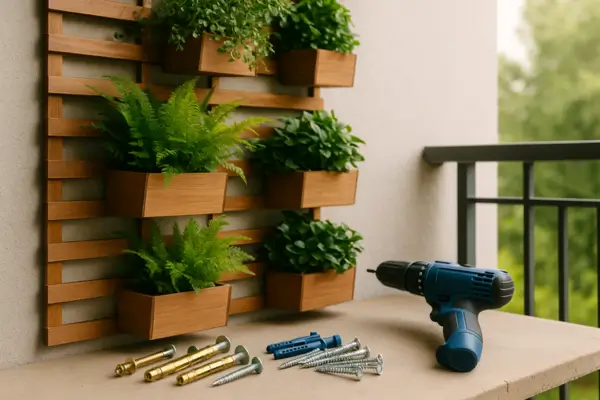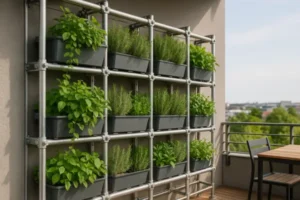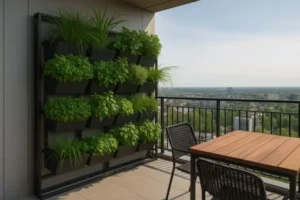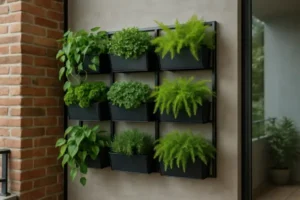Choosing the best wall anchors and screws for installing vertical gardens on balconies is one of those small steps that make a big difference. If you plan on hanging your garden and enjoying it every day, using the right fasteners will help keep everything in place.
Balcony walls are not all created equal, and that’s okay. Some are solid, others are more delicate — but there’s always a simple way to make things work. It all comes down to knowing what goes with what.
Here, you’ll find tips and the best tool options to help you confidently create your vertical garden and enjoy the results.
Best Wall Anchors and Screws for Installing Vertical Gardens on Balconies
Choosing the best wall anchors and screws for installing vertical gardens on balconies starts with one simple question: what kind of wall are you working with? Not all balconies are created equal.
Some have brick, others concrete, and some use hollow paneling or drywall-style surfaces. That’s why a “universal” anchor doesn’t really exist.
Understanding the Basics: Why Anchors Matter
The best wall anchors and screws for installing vertical gardens on balconies are the ones that bring stability and confidence to your setup. They help the screws hold everything firmly in place, so your garden stays just the way you imagined.
Balconies bring unique conditions—sun, breeze, a bit of humidity, and of course, the natural weight of soil, planters, and water. With the right anchors, all of this is well-supported, keeping your garden secure and looking great over time.
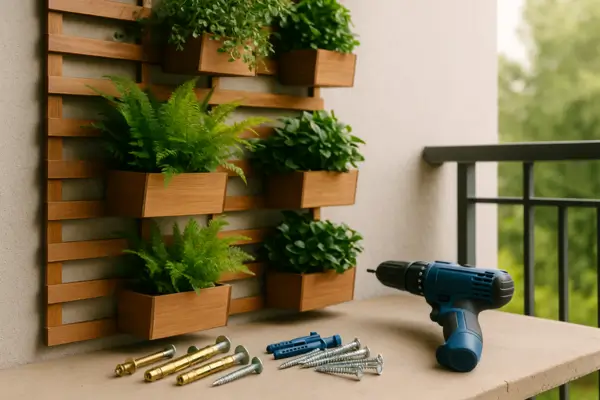
That’s why your anchor setup needs to handle three main types of force:
- Shear (side-to-side pull, like when wind pushes against your garden)
- Tension (straight pull from the weight of the garden hanging down)
- Vibration and expansion (caused by temperature changes or movement)
The right anchor balances all three.
Common Mistakes People Make
Many vertical garden guides gloss over the assembly process, assuming people will figure it out. But a screw that’s the wrong size, a plastic anchor for indoor shelving, or an incompatible drill bit can ruin your wall — or worse, leave your plants unsupported.
Here’s what you should always check:
- Anchor size vs. screw diameter
- Wall depth (is it thick enough for a deep anchor?)
- Outdoor durability (is the material rust-resistant?)
- Load rating (how much weight can it actually support?)
These details are usually on the packaging, but many people overlook them. Reading the instructions carefully can save you time and money.
Pro Tip Most People Skip
If your wall feels brittle or soft when you drill, stop immediately. This usually means it can’t support an anchor as intended. In these cases, a freestanding modular system or a garden structure with tension posts may be safer — no drilling required.
Sleeve Anchors for Concrete and Brick Walls
When looking for the best wall anchors and screws for installing vertical gardens on balconies, sleeve anchors are a top choice—especially if your walls are made of concrete or brick.
They’re built for solid, dense surfaces and give strong support without the need for complicated tools or extra mounting parts.
How Sleeve Anchors Work
Sleeve anchors expand inside the hole you drill, locking themselves into place as you tighten the bolt or screw. Unlike plastic wall plugs, which compress, sleeve anchors are made of metal and create outward pressure against the sides of the hole. That’s what gives them their grip.
This makes them especially good for:
- Heavy planters or modular garden systems
- Walls that face strong wind or shifting weather
- Long-term durability without loosening
Things to Keep in Mind
Before using sleeve anchors, you’ll need a hammer drill and a masonry bit that matches the anchor’s diameter. The hole must be deep enough to fit the entire anchor, and clean from dust before inserting.
You also need to:
- Check the depth of the wall to avoid drilling through thin layers
- Use zinc-coated or stainless steel versions to resist rust
- Choose a sleeve length based on what you’re hanging—some garden systems need deeper anchoring than others
Quick Pros and Cons
| Pros | Cons |
|---|---|
| High load capacity | Requires masonry drill |
| Great for concrete and brick | Not for hollow walls |
| Strong, secure hold | Must match the anchor size exactly |
Many people overlook sleeve anchors because they’re not as “plug-and-play” as other options, but for balconies with solid walls, they’re hard to beat in terms of strength and longevity.
Toggle Bolts for Hollow or Panel-Type Balcony Walls
When choosing the best wall anchors and screws for installing vertical gardens on balconies, toggle bolts are a smart solution for hollow walls like drywall-style panels or thin composite surfaces. These anchors open up behind the wall, creating a firm internal grip that holds everything securely in place.
How Toggle Bolts Work
A toggle bolt comes with spring-loaded wings that fold down so you can insert them into a pre-drilled hole. Once inside the wall, the wings pop open and create a wide anchor surface behind the panel.
When you tighten the screw, it pulls the wings snug against the back of the wall, giving you a solid and stable mount.
These bolts are especially useful when:
- The wall material can’t support pressure from a standard anchor
- There’s a cavity behind the wall where wings can expand
- You’re installing medium-weight to heavy garden systems and want a backup plan
A Few Important Notes
Toggle bolts need a larger hole than most anchors, since the wings have to pass through before expanding. This also means that if you ever remove the bolt, there’ll be a visible hole that can’t be reused without patching.
Here’s what else you need to watch:
- Measure the thickness of the wall so you pick a bolt with long enough threads
- Use nylon spacers if needed to prevent crushing lightweight materials
- Choose bolts with corrosion-resistant coatings, especially if the balcony gets wet
Best Use Cases for Vertical Gardens
Toggle bolts are ideal for:
- Vertical garden panels attached to balcony drywall or composite boards
- Hanging structures where weight is distributed across multiple points
- Balconies where drilling into solid masonry isn’t an option
With the right prep, toggle bolts offer surprising strength—and a bit of peace of mind—when mounting to less-than-sturdy surfaces.
Plastic Expansion Anchors for Lightweight Vertical Gardens
If your vertical garden setup is light and your balcony wall is made of drywall, thin plaster, or wood paneling, plastic expansion anchors can do the job—if chosen and installed correctly.
They’re one of the most common types of wall anchors, but often misunderstood or misused.
How Plastic Anchors Work
These anchors are simple: you drill a hole, insert the plastic sleeve, and then drive a screw into it. As the screw goes in, it expands the plastic outward, creating pressure against the sides of the hole. That’s what holds it in place.
They’re best suited for:
- Hanging lightweight vertical planters
- Attaching support brackets or thin wooden frames
- Temporary or experimental garden layouts
If you’re working with herbs, succulents, or small decorative plants in a vertical frame, this option can keep things secure without the need for power tools or heavy hardware.
Avoiding the Common Pitfalls
The most frequent issue with plastic expansion anchors is choosing the wrong size—or using them where they can’t grip. Many people also skip pre-drilling, which causes the anchor to bend or break.
To avoid problems:
- Always match the anchor size to your screw
- Pre-drill the hole with the correct bit diameter
- Don’t use them in hollow or crumbly walls
- Choose ribbed or flanged designs for better hold
And one more tip: don’t overtighten the screw. This can spin the anchor loose, ruining the hole.
Are They Enough for a Balcony Setup?
Yes, but only for very specific cases. If you’re mounting a single lightweight vertical planter or a small herb rack, plastic anchors may be all you need. Just make sure they’re rated for indoor/outdoor use, especially if there’s exposure to moisture or temperature changes.
Masonry Screws (Tapcon) for Direct Mounting on Concrete and Brick
For balcony walls made of concrete or brick, masonry screws—often called Tapcon screws—offer a clean and efficient way to install vertical garden systems without the need for separate anchors.
These screws are engineered to bite directly into masonry, making them a favorite for fast, secure installs.
What Makes Tapcon Screws Different
Among the best wall anchors and screws for installing vertical gardens on balconies, Tapcon masonry screws stand out for their precision and strength. These screws have hardened threads that cut directly into concrete, brick, or block, giving you a solid hold from the start.
They usually come with hex or Phillips heads and include a matching carbide-tipped drill bit, so there’s no guesswork involved. Once in place, they offer reliable grip, resist vibration, and can be removed or repositioned when needed—something most expansion anchors don’t allow.
They’re ideal for:
- Modular vertical garden panels
- Heavy-duty metal frames
- Balconies with thick, solid wall surfaces
Tips for Installation
To get the most out of masonry screws:
- Use a hammer drill, not a standard drill. This ensures clean entry into hard surfaces.
- Drill to the exact depth of the screw (plus a bit more to clear debris).
- Clean out the hole before inserting the screw—dust can reduce holding power.
- Choose screws with corrosion-resistant coating, like blue or stainless Tapcon variants.
When Are Masonry Screws Better Than Anchors?
Use them when you want:
- A neater look (no bulky anchors or sleeves)
- Fewer materials and faster setup
- A connection you can remove later without wall damage
Just remember: these screws don’t work on soft or hollow walls. You need solid mass behind them to bite into—otherwise, they’ll spin uselessly.
Self-Drilling Drywall Anchors for Quick Installs on Hollow Walls
If you’re dealing with drywall or panel-style balcony walls and want a faster, tool-free option, self-drilling drywall anchors are a great pick—as long as your vertical garden setup is lightweight.
These anchors are designed for easy installation without needing a pre-drilled hole, making them perfect for small projects or renters who want to avoid heavy drilling.
How They Work
Self-drilling drywall anchors (also known as threaded anchors) screw directly into the wall using a standard screwdriver. Their wide, spiral threads cut into the wall surface, providing stability without the need for expansion mechanisms or toggle systems.
They’re best used for:
- Small vertical herb gardens or modular panels with plastic frames
- Walls that don’t support larger holes
- Projects where simplicity and speed matter more than weight support
What to Watch For
Even though they’re easy to use, these anchors do have limitations. They’re not suitable for concrete or brick, and they shouldn’t be used for garden systems that retain water or hold heavy pots.
Here’s how to make them work properly:
- Use plastic or metal versions rated for outdoor exposure
- Screw them in straight and slowly, avoiding overpressure
- Pair them with the right screw length—too short and it won’t reach, too long and it may break through the other side
Ideal Use Cases for Vertical Gardens
Self-drilling drywall anchors are perfect when:
- You’re setting up a compact vertical herb garden
- Your balcony wall has thin panels or plasterboard
- You want minimal wall damage and an easy uninstall process
These anchors are surprisingly strong for their size—but only when used within their limits. When the load stays light, they offer a fast, no-hassle solution.
Snap Toggle Anchors for Extra Support on Hollow Walls
If you’re looking for a stronger alternative to classic toggle bolts, especially when working with hollow or drywall balcony walls, snap toggle anchors offer modern performance with less mess and more precision.
These anchors combine the holding strength of toggle wings with a faster, more controlled installation.
What Sets Snap Toggles Apart
Unlike traditional toggle bolts, snap toggles use a metal channel that stays in place behind the wall, held by a long plastic strap.
Once inserted through a pre-drilled hole, the metal toggle flips open, and the strap lets you pull it tight against the inside of the wall. You then snap off the excess plastic and insert a bolt through the metal threads embedded in the toggle.
It sounds more complex than it is—but the payoff is a cleaner, stronger hold, especially useful for:
- Larger vertical garden panels with metal or wood framing
- Systems that involve uneven weight distribution
- Installations requiring precise alignment (since you can thread in and out multiple times)
Why They’re Great for Balcony Projects
Snap toggles work well in situations where you:
- Can’t reach behind the wall
- Need to hang heavier garden frames on drywall
- Want a reusable anchor that lets you swap bolts without losing the anchor inside the wall
They’re also great when:
- You’re dealing with fragile wall materials and need a wide load spread
- You prefer a bolt-driven system instead of screwing directly into plastic
A Few Practical Notes
Before installing snap toggles, make sure to:
- Drill a clean, accurate hole (usually ½ inch, depending on the model)
- Choose the right bolt length to match your vertical garden frame
- Use zinc-plated or stainless bolts for moisture resistance
These anchors are more expensive than basic plastic or toggle versions, but they provide professional-grade strength—perfect for renters or homeowners who want peace of mind without damaging walls beyond repair.
Concrete Sleeve Bolts for Heavy-Duty Vertical Gardens
When you’re installing a large or permanent vertical garden system on a solid balcony wall—especially concrete—concrete sleeve bolts deliver one of the most secure and load-bearing solutions available.
They’re the go-to choice for professional installations where strength and long-term stability are top priorities.
How They Work
Concrete sleeve bolts, also called through bolts or wedge anchors, are inserted into a hole that’s drilled through both the mounting bracket and the concrete wall.
As the bolt is tightened, a metal sleeve at the base expands, gripping the inside of the concrete and locking the bolt into place.
They’re not just secure—they’re practically permanent. That’s why they’re widely used in construction, shelving systems, and commercial-grade mounting.
These bolts are perfect for:
- Multi-tiered or stacked vertical gardens
- Installations with wooden panels, metal grids, or heavy ceramic pots
- Outdoor walls that face wind or regular watering routines
Things to Know Before Installing
Concrete sleeve bolts need proper prep and tools. Here’s how to make sure they work right:
- Use a hammer drill with a masonry bit sized to the anchor
- Drill straight through the mounting bracket into the wall—don’t pre-drill the wall alone
- Clear the dust completely to avoid weak expansion
- Choose rust-resistant sleeves and bolts, especially for outdoor exposure
One unique advantage: because the bolt passes through your garden mount and into the wall in a single step, there’s no need to mark and drill separately. It makes installation more accurate, especially for heavier garden panels.
When You Should Choose Sleeve Bolts
Go with this option if:
- You want zero movement over time, even with frequent watering
- You’re installing into dense concrete or solid brick
- You’re planning a long-term setup that won’t be changed seasonally
The only drawback? They’re harder to remove than other options. Once installed, they’re there to stay—so be sure of your layout before you drill.
Conclusion
Creating a vertical garden on your balcony starts with the right foundation—and that means choosing the best wall anchors and screws for installing vertical gardens on balconies. With the right combination, you set up something that’s not just beautiful, but also built to last.
Each anchor type brings its own strengths. Whether you’re working with solid concrete or light panel walls, there’s a simple solution that fits your space and makes the setup feel smooth from the start.
Once it’s in place, your garden becomes part of your daily life—adding a fresh, green touch every time you step outside. With the right anchors, you can enjoy that space fully, knowing it’s all working just the way it should.

